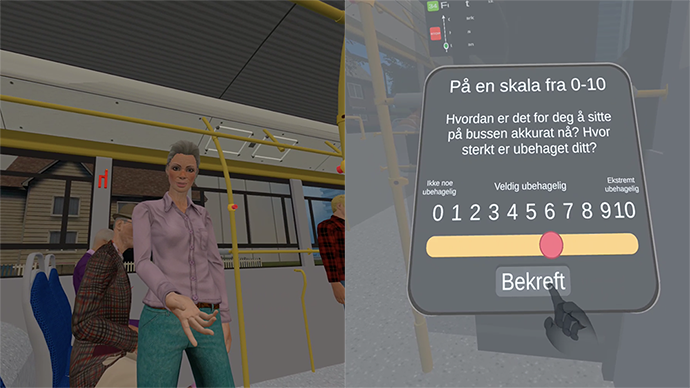How can Virtual Reality (VR) technology and artificial intelligence be used to improve the treatment of people struggling with schizophrenia and other similar serious psychoses?
This is what Professor Jan Ivar Røssberg and Associate Professor June Ullevoldsæter Lystad at the Department of Psychology intend to find out.

They have received funding from the SPARK Social Innovation program for their project RecoVRy: Artificial Intelligence powered Virtual Reality Therapy in Psychosis Treatment.
The researchers plan to develop a program using Virtual Reality (VR) in treating patients with serious psychotic disorders like schizophrenia.
"This is a project we are very passionate about. We strongly believe that this could have a positive impact on the treatment of this patient group," says Røssberg.
"The grant from SPARK Social Innovation has been vital in making this project happen.”
What is Virtual Reality?
VR is a technology where you use a headset, almost like goggles, that allow you to be in a computer-generated environment. This environment is perceived as very real by the person wearing the headset.
While wearing the headset you can both influence the environment around you and be affected by your life-like surroundings.
"We refer to what happens in the computer-generated environment as a simulation. VR stimulates different senses, such as visual impressions, sounds, vibrations, and movement. Thus, it creates an engaging environment that resembles reality," explains Røssberg.
VR tailored for Norwegian patients
VR treatments involve using this technology to improve psychological care. It has previously been used in treating phobias.
"This project is about treating patients with serious mental disorders such as schizophrenia and other psychosis-like conditions," he says.
Schizophrenia is a severe mental disorder characterized by delusions and hallucinations. The disorder is associated with intense anxiety. Many with schizophrenia hesitate to go out and socialize with other people. They are anxious about going to work and end up isolating themselves.
Røssberg and Lystad have developed a VR application named RecoVRy. It is tailored for Norwegian patients with typical Norwegian environments using the Norwegian language.
"The target group is individuals with serious psychotic disorders who experience strong anxiety in everyday situations," he says.
Creating realistic scenarios for the patients
Through RecoVRy, patients can immerse themselves in a whole range of simulated scenarios. These can be situations such as bus journeys, café visits, public waiting rooms, job interviews, or conversations with an advisor at NAV (Norwegian Labour and Welfare Administration).
These are all typical situations that the researchers know can trigger anxiety for their patients.
"The scenarios are designed to reflect anxiety-inducing factors in the patients' lives. Thus, they can practice handling these situations in safe, controlled environments together with their therapist," explains the Professor.

Genuine conversations with avatars
An important function in RecoVRy is created through the integration of artificial intelligence. This makes it possible to have realistic, non-scripted conversations in RecoVRy with virtual people, so-called avatars.
"Through conversation, the avatar can detect anxiety in the user based on their choice of words. Then they can give a more empathetic and encouraging response in return. This creates a more genuine interaction which gives the user room to explore their own real reactions in various social situations," explains Røssberg.
"At the same time, it increases the likelihood that individual users experience the scenarios as relevant and useful, thus contributing to more personalized treatment," he adds.
RecoVRy is based on principles from cognitive behavioral therapy
Patients are also guided through the scenarios using elements from games. They are systematically introduced to principles and goals based on cognitive behavioral therapy (CBT) through each session.
"This application is based on key principles from CBT. This design approach ensures that important principles from the treatment are standardized and presented to all users," Røssberg explains.
"At the same time, it opens the possibility that therapists without CBT training can use the intervention with patients. This can potentially help even more patients," he says.
Patients are exposed to anxiety-inducing situations while in therapy
"We have previously had two projects with cognitive therapy for this patient group. The results have not been the best and there is clearly room for improvement," says Røssberg.
Part of that, he reasons, is that too much time passes between the situation that triggers anxiety and when the patient can discuss it with a therapist.
"But when we use VR glasses with realistic scenarios, we can talk through the situation, while they are experiencing it. They are exposed to what they fear while they are in therapy. That makes the treatment effect much greater," he says.
What is SPARK Social Innovation?
SPARK Social Innovation is a two-year innovation program for researchers at UiO.
Social innovation is about sharing ideas and further developing them together. It's about products and initiatives that can improve services or add value to the community.
